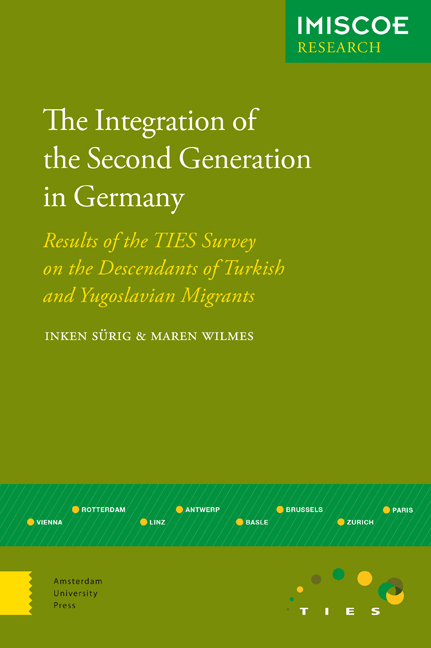 The Integration of the Second Generation in Germany
The Integration of the Second Generation in Germany Book contents
- Frontmatter
- Contents
- Preface: The International Research Project TIES
- 1 Introduction
- 2 Migration History and Basic Demographic Characteristics of the First Generation
- 3 Educational Careers and Educational Outcomes
- 4 Labour Market Positions
- 5 Segregation and Housing
- 6 Ethnic and Cultural Orientations
- 7 Social Relations
- 8 Family Formation and Partner Relationships
- 9 Conclusions and International Comparisons
- References
- Other IMISCOE Research Titles
1 - Introduction
Published online by Cambridge University Press: 11 December 2020
- Frontmatter
- Contents
- Preface: The International Research Project TIES
- 1 Introduction
- 2 Migration History and Basic Demographic Characteristics of the First Generation
- 3 Educational Careers and Educational Outcomes
- 4 Labour Market Positions
- 5 Segregation and Housing
- 6 Ethnic and Cultural Orientations
- 7 Social Relations
- 8 Family Formation and Partner Relationships
- 9 Conclusions and International Comparisons
- References
- Other IMISCOE Research Titles
Summary
This book presents a research report on the results of the TIES survey conducted in Germany in 2008. It elaborates various aspects of the integration of the second generation with a Turkish and Yugoslavian migration background in Berlin and Frankfurt. Topics covered include educational careers and educational outcomes, labour market positions, segregation and housing, ethnic and cultural orientations, social relations, and family formation and partner relationships. The focus of the report is the description and classification of quantitatively ascertained empirical data. It discusses a broad range of issues from migration research concerning the integration process of second generations. The relevance of this sort of research lies partly in its potential to clarify whether or not the German-born children of labour migrants have the same chances and opportunities as the children of native-born parents. A first, but important approach to answer this question is the following extensive description of second-generation migrants in various areas of German society.
The integration of the second generation: Theoretical considerations
There is a common expectation in migration research that the second generation of immigrants in Europe will be better adapted to and integrated into the different spheres of the receiving society than the first generation. Second-generation migrants are often assumed to be in the process of gaining equality with the majority population, a process that will lead to complete assimilation of the generations to come. They are thus seen as living in a transitional era in many respects. Another general understanding, however, is that migration shapes the host societies as much as these societies shape migration. Migrants of the second generation are therefore not simply the product of more or less successful integration into the society of a nation state. Instead, the societies in question are also the product of long-term migration processes, which endow them with greater cultural, linguistic, religious, and ‘phylogenetic’ diversity and plurality. For second-generation immigrants, following in the footsteps of the first, parental generation, ‘integration’ does not simply mean ‘assimilation’ into a well-defined majority. It means adjustment to multicultural, multilingual, and multi-religious neighbourhoods, schools, labour markets, and so on.
- Type
- Chapter
- Information
- The Integration of the Second Generation in GermanyResults of the TIES Survey on the Descendants of Turkish and Yugoslavian Migrants, pp. 9 - 16Publisher: Amsterdam University PressPrint publication year: 2015


